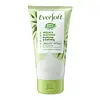What's inside
What's inside
 Key Ingredients
Key Ingredients

 Benefits
Benefits

 Concerns
Concerns

 Ingredients Side-by-side
Ingredients Side-by-side

Water
Skin ConditioningPEG-8
HumectantMyristic Acid
CleansingStearic Acid
CleansingPotassium Hydroxide
BufferingPalmitic Acid
EmollientGlycerin
HumectantLauric Acid
CleansingButylene Glycol
HumectantGlyceryl Stearate Se
EmulsifyingPolyquaternium-7
Tetrasodium EDTA
BHT
AntioxidantPEG-90m
Emulsion StabilisingMelia Azadirachta Leaf Extract
Skin ConditioningCamellia Sinensis Leaf Extract
AntimicrobialMother Of Pearl
AbrasiveGlycerin
HumectantPotassium Myristate
EmulsifyingWater
Skin ConditioningButylene Glycol
HumectantPotassium Cocoyl Glycinate
Potassium Stearate
CleansingCocamidopropyl Betaine
CleansingMyristic Acid
CleansingSodium Methyl Cocoyl Taurate
CleansingPotassium Laurate
EmulsifyingPEG-40 Stearate
EmulsifyingLauric Acid
CleansingGlyceryl Stearate
EmollientPEG-100 Stearate
Parfum
MaskingStearic Acid
CleansingTocopheryl Acetate
AntioxidantCordyceps Sinensis Extract
AntioxidantPhellinus Linteus Extract
Skin ConditioningPhellinus Linteus/Rice Ferment Extract
EmollientPhellodendron Amurense Bark Extract
Skin ConditioningRheum Palmatum Root/Stalk Extract
AstringentScutellaria Baicalensis Root Extract
AstringentSophora Angustifolia Root Extract
Skin ConditioningAlthaea Officinalis Leaf/Root Extract
EmollientAnthemis Nobilis Flower Extract
MaskingFoeniculum Vulgare Leaf Extract
HumectantHouttuynia Cordata Extract
Skin ConditioningLavandula Angustifolia Flower
Skin ConditioningOcimum Basilicum Flower/Leaf Extract
TonicRosmarinus Officinalis Extract
AntimicrobialBeta-Glucan
Skin ConditioningTrisodium EDTA
Pyrus Malus Fruit Water
Masking1,2-Hexanediol
Skin ConditioningGlycerin, Potassium Myristate, Water, Butylene Glycol, Potassium Cocoyl Glycinate, Potassium Stearate, Cocamidopropyl Betaine, Myristic Acid, Sodium Methyl Cocoyl Taurate, Potassium Laurate, PEG-40 Stearate, Lauric Acid, Glyceryl Stearate, PEG-100 Stearate, Parfum, Stearic Acid, Tocopheryl Acetate, Cordyceps Sinensis Extract, Phellinus Linteus Extract, Phellinus Linteus/Rice Ferment Extract, Phellodendron Amurense Bark Extract, Rheum Palmatum Root/Stalk Extract, Scutellaria Baicalensis Root Extract, Sophora Angustifolia Root Extract, Althaea Officinalis Leaf/Root Extract, Anthemis Nobilis Flower Extract, Foeniculum Vulgare Leaf Extract, Houttuynia Cordata Extract, Lavandula Angustifolia Flower, Ocimum Basilicum Flower/Leaf Extract, Rosmarinus Officinalis Extract, Beta-Glucan, Trisodium EDTA, Pyrus Malus Fruit Water, 1,2-Hexanediol
 Reviews
Reviews

Ingredients Explained
These ingredients are found in both products.
Ingredients higher up in an ingredient list are typically present in a larger amount.
Butylene Glycol (or BG) is used within cosmetic products for a few different reasons:
Overall, Butylene Glycol is a safe and well-rounded ingredient that works well with other ingredients.
Though this ingredient works well with most skin types, some people with sensitive skin may experience a reaction such as allergic rashes, closed comedones, or itchiness.
Learn more about Butylene GlycolGlycerin is already naturally found in your skin. It helps moisturize and protect your skin.
A study from 2016 found glycerin to be more effective as a humectant than AHAs and hyaluronic acid.
As a humectant, it helps the skin stay hydrated by pulling moisture to your skin. The low molecular weight of glycerin allows it to pull moisture into the deeper layers of your skin.
Hydrated skin improves your skin barrier; Your skin barrier helps protect against irritants and bacteria.
Glycerin has also been found to have antimicrobial and antiviral properties. Due to these properties, glycerin is often used in wound and burn treatments.
In cosmetics, glycerin is usually derived from plants such as soybean or palm. However, it can also be sourced from animals, such as tallow or animal fat.
This ingredient is organic, colorless, odorless, and non-toxic.
Glycerin is the name for this ingredient in American English. British English uses Glycerol/Glycerine.
Learn more about GlycerinLauric Acid is a fatty acid or lipid. About half of fatty acids in coconut oil is lauric acid.
This ingredient helps hydrate and sooth skin. As a humectant, it helps trap moisture. It also aids in cleaning and enhancing the texture of products.
Lauric acid may not be Malassezia folliculitis, or fungal acne, safe.
Learn more about Lauric AcidMyristic Acid is a saturated fatty acid. It is naturally found in milk fat. Other sources include palm oil, coconut oil, and butter fat.
Myristic Acid is an emulsifer and cleanser. As an emulsifer, it stabilizes a product by preventing ingredients from separating. Myristic Acid helps clean your skin by acting as a surfactant. It tends to gather oil and dirt on your skin to be easily rinsed away.
One study from 2021 found Myristic Acid to have anti-inflammatory properties.
Learn more about Myristic AcidStearic Acid is a fatty acid. It is an emollient, emulsifier, and texture enhancer.
As an emollient, stearic acid helps soften skin. It aids the skin's protective barrier by preventing water loss. It also provides a gentle cleansing effect without stripping away natural oils.
Stearic acid may also be used to enhance the texture of products. It can add volume and stabilize ingredients such as water and oil. This can help water and oil ingredients from separating.
Sources of stearic acid include animal or vegetable fats/oils such as coconut or shea. It can be naturally found in butter, cocoa butter, shea butter, vegetable fats, and animal tallow.
This ingredient may not be Malassezia folliculitis, or fungal-acne safe.
Learn more about Stearic AcidWater. It's the most common cosmetic ingredient of all. You'll usually see it at the top of ingredient lists, meaning that it makes up the largest part of the product.
So why is it so popular? Water most often acts as a solvent - this means that it helps dissolve other ingredients into the formulation.
You'll also recognize water as that liquid we all need to stay alive. If you see this, drink a glass of water. Stay hydrated!
Learn more about Water